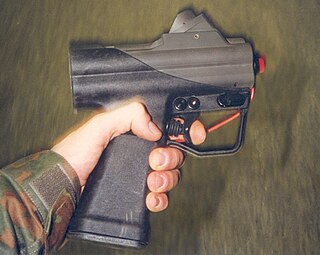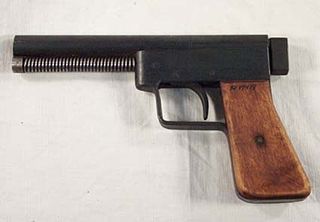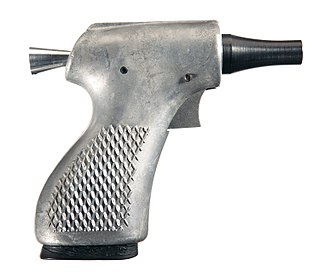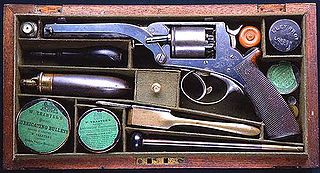
A firearm is any type of gun that uses an explosive charge and is designed to be readily carried and operated by an individual. The term is legally defined further in different countries.

A submachine gun (SMG) is a magazine-fed automatic carbine designed to fire handgun cartridges. The term "submachine gun" was coined by John T. Thompson, the inventor of the Thompson submachine gun, to describe its design concept as an automatic firearm with notably less firepower than a machine gun. As a machine gun must fire rifle cartridges to be classified as such, submachine guns are not considered machine guns.

A semi-automatic rifle is an autoloading rifle that fires a single cartridge with each pull of the trigger. It uses part of the fired cartridge's energy to eject the case and automatically loads another cartridge into its chamber. This is in contrast to bolt-action rifles, which require the user to cycle the bolt manually before they can fire a second time, and fully automatic rifles, which fire continuously until the trigger is released.
The Pancor Corporation Jackhammer is a 12-gauge, blow-forward gas-operated bullpup automatic shotgun designed in 1984 and patented in 1987. Only three working prototypes of the Jackhammer were built. Nonetheless, its distinctive aesthetics and futuristic design have made it popular as a weapon in many video games, notably Fallout 2, Max Payne and Far Cry.

The STEN is a British submachine gun chambered in 9×19mm which was used extensively by British and Commonwealth forces throughout World War II and during the Korean War. The Sten paired a simple design with a low production cost, facilitating mass production to meet the demand for submachine guns.

The National Firearms Act (NFA), 73rd Congress, Sess. 2, ch. 757, 48 Stat. 1236 was enacted on June 26, 1934, and currently codified and amended as I.R.C. ch. 53. The law is an Act of Congress in the United States that, in general, imposes an excise tax on the manufacture and transfer of certain firearms and mandates the registration of those firearms. The NFA is also referred to as Title II of the federal firearms laws, with the Gun Control Act of 1968 ("GCA") as Title I.

The Mauser C96 is a semi-automatic pistol that was originally produced by German arms manufacturer Mauser from 1896 to 1937. Unlicensed copies of the gun were also manufactured in Spain and China in the first half of the 20th century.

The Walther PP series pistols are blowback-operated semi-automatic pistols, developed by the German arms manufacturer Carl Walther GmbH Sportwaffen.

The Heckler & Koch P11 is an underwater firearm developed in 1976 by Heckler & Koch. It is loaded using a pepper-box-like assembly, containing five sealed barrels each containing an electrically-fired projectile. Two styles of barrel assembly can be used: one containing five 7.62×36mm flechette darts for use underwater, or five 133-grain bullets for use above water.

The Welrod is a British bolt-action, magazine-fed, suppressed pistol devised during the Second World War by Major Hugh Reeves at the Inter-Services Research Bureau. Station IX, being based in Welwyn, gave the Welrod its unusual name, being derived from "Wel" from "Welwyn" and "rod", gangland slang for gun, as a way to obscure its purpose.

The FN Browning M1900 is a single action semi-automatic pistol designed c. 1896 by John Browning for Fabrique Nationale de Herstal (FN) and produced in Belgium at the turn of the 20th century. It was the first production handgun to use a slide.

The Colt Model 1903 Pocket Hammerless is a .32 ACP caliber, self-loading, semi-automatic pistol designed by John Browning and built by Colt Patent Firearms Manufacturing Company of Hartford, Connecticut. The Colt Model 1908 Pocket Hammerless is a variant introduced five years later in .380 ACP caliber. Despite the title "hammerless", the Model 1903 does have a hammer. The hammer is covered and hidden from view under the rear of the slide, this allows the pistol to be carried in and withdrawn from a pocket quickly and smoothly without snagging.

An Apache revolver is a handgun which incorporates multiple other weapons, made notorious by the French underworld figures of the early 1900s known as Les Apaches.

Improvised firearms are firearms manufactured other than by a firearms manufacturer or a gunsmith, and are typically constructed by adapting existing materials to the purpose. They range in quality, from crude weapons that are as much a danger to the user as the target, to high-quality arms produced by cottage industries using salvaged and repurposed materials.

The Deer gun, developed by the CIA, was a successor to the Liberator pistol. The single-shot Deer gun was intended for distribution to South Vietnamese guerrillas as a weapon against North Vietnamese soldiers.

A handgun is a firearm designed to be usable with only one hand. It is distinguished from a long barreled gun which needs to be held by both hands and braced against the shoulder. Handguns have shorter effective ranges compared to long guns, and are much harder to shoot accurately. While most early handguns are single-shot pistols, the two most common types of handguns used in modern times are revolvers and semi-automatic pistols, although other handguns such as derringers and machine pistols also see infrequent usage.

The PSM was designed by the Tula Design Bureau in 1969 as a self-defense firearm for law enforcement and military officers of the USSR. The pistol entered production at the Izhevsk Mechanical Plant in 1973.

The Tranter revolver was a double-action cap & ball revolver invented around 1856 by English firearms designer William Tranter (1816–1890). Originally operated with a special dual-trigger mechanism later models employed a single-trigger mechanism much the same as that found in the contemporary Beaumont–Adams revolver.

The Volkspistole was a prototype pistol produced by Carl Walther GmbH, Mauser-Werke and Gustloff-Werke in 1945 for an emergency German pistol design to help mitigate the loss of pistols before the war's end in Europe.
Forgotten Weapons is a website and channel appearing on YouTube, Utreon, Full30 and Floatplane, created and presented by Ian McCollum. Forgotten Weapons covers the history of antique, obscure, and historically important firearms.



















